Mastering Toothbrushing: Techniques for Optimal Oral Health
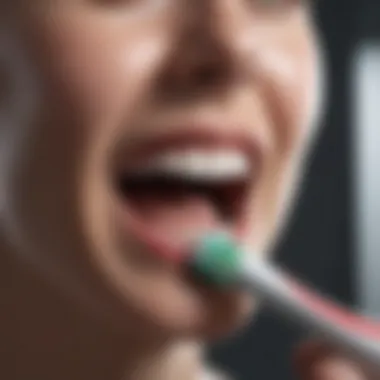
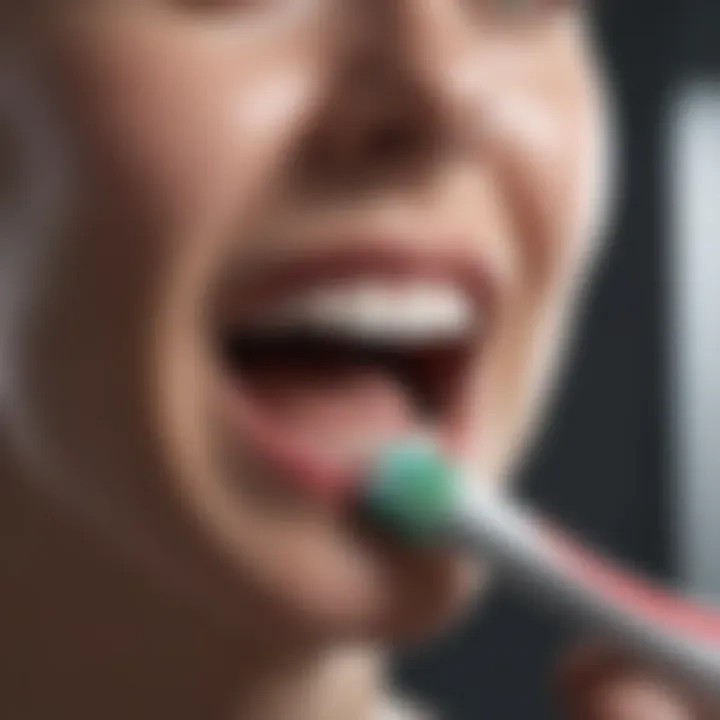
Intro
Tooth brushing is a fundamental practice in maintaining oral health. Many people assume it is an uncomplicated task; however, the right techniques, tools, and approaches can make a significant impact on your dental hygiene. This section aims to set the stage for a comprehensive discussion on tooth brushing techniques, addressing not merely the mechanics of brushing, but also the implications of regular practices and the understanding of oral health.
Brushing the teeth is not just about aesthetics—it plays a crucial role in preventing cavities, gum disease, and other dental issues. Understanding the relationship between effective brushing and overall health can empower individuals to adopt better habits. Many may overlook the importance of frequency and duration, assuming that brushing once or twice a day is sufficient. It is essential to delve deeper into these aspects to refine and enhance one’s brushing routine.
Evidence suggests that proper brushing techniques combined with suitable tools can lead to marked improvements in oral health outcomes. As this guide progresses, readers will encounter various methodologies of brushing, ranging from the traditional manual toothbrush to electric and sonic variants. Each approach has its merits and specific functionalities worth exploring.
Furthermore, misconceptions surround tooth brushing that can lead to ineffective practices. By exposing these myths and educating on evidence-based recommendations, readers will be better equipped to develop a successful brushing strategy tailored to their individual needs.
In subsequent sections, we will cover the mechanics of different brushing methods, explore the science behind each technique, and offer insights supported by current research.
Preamble to Toothbrushing Techniques
Toothbrushing is an essential part of oral care. It is a daily ritual for promoting good dental health. This article aims to explain various toothbrushing techniques in detail. Mastery of these techniques is crucial. Understanding the fundamentals will lead to better hygiene practices and improved overall health.
Importance of Oral Hygiene
Oral hygiene is vital for more than just a pleasant smile. Poor oral care can lead to serious dental issues. Tooth decay, gum disease, and even infections can all arise from neglecting one's oral health. Moreover, research links oral health to systemic health. Conditions like heart disease and diabetes have connections to oral hygiene. Regular brushing can reduce plaque, prevent cavities, and maintain gum health. Regular brushing is not merely a recommendation but a requirement for long-term health.
"Good oral hygiene is the foundation for overall health, reducing the risk of many diseases."
Purpose of Toothbrushing
The primary purpose of toothbrushing is plaque removal. Plaque forms a sticky film of bacteria on teeth and gums. If not removed, it hardens into tartar, leading to more serious issues. Toothbrushing helps to dislodge food particles and bacteria. This process enhances fresh breath and reduces the risk of cavities.
Toothbrushing also serves to apply toothpaste benefits. Many toothpastes contain fluoride. Fluoride strengthens tooth enamel, making it more resistant to decay. Different techniques contribute to efficiency in this process. Choosing the right method can intensify the effectiveness of each brushing session. Understanding these techniques ensures that one gets the maximum benefit from brushing. Thus, it is clear that brushing paints a comprehensive picture of oral care.
Anatomy of the Tooth and Gums
Understanding the anatomy of the tooth and gums is essential for effective oral hygiene practices. This section delves into the structural elements that make up the tooth and adjacent gum tissue. By grasping how teeth and gums are designed, individuals can better appreciate their role in overall oral health and enhance their toothbrushing techniques. The health of both teeth and gums can directly affect one's overall oral health. Focusing on these components can lead to significant improvements in dental care routines.
Structure of Teeth
Teeth consist of several distinct layers, each crucial for their function and durability. The outermost layer is the enamel, a hard, protective coating. Enamel is the hardest substance in the human body and plays a vital role in guarding against decay. Underneath the enamel lies the dentin, which is less hard but still provides strength and support to the tooth. Dentin contains tiny tubules that can transmit sensations, which is why sensitivity can occur if enamel is eroded.
Further below the dentin is the pulp, which houses nerves and blood vessels. This inner part is crucial for the tooth's nourishment and health. The pulp can become infected due to decay or trauma, possibly leading to severe pain or tooth loss. Understanding these layers helps in comprehending why proper brushing is necessary.
Gum Health and Oral Care
Healthy gums are foundational in maintaining overall dental health. The gingiva, or gum tissue, surrounds each tooth and acts as a protective barrier. Healthy gums are firm and do not bleed during brushing. If plaque is not removed effectively, it can harden into tartar, leading to gingivitis or more severe periodontal diseases.
Maintaining gum health involves regular brushing to remove plaque, supplemented by flossing to reach areas between the teeth that the toothbrush cannot. Individuals should also consider using a mouthwash with antiseptic properties to further protect gum health. Regular dental visits can provide necessary assessments of gum health and catch any potential issues early on.
In summary, being versed in the anatomy of teeth and gums enhances one's ability to carry out effective oral hygiene practices, leading to better long-term outcomes.
"Good oral hygiene starts with understanding the basic structures within the mouth."
By recognizing the crucial components of the tooth and gums, one can appreciate the importance of proper brushing techniques and their implications for oral health.
Types of Toothbrushes
Toothbrushes play a crucial role in maintaining oral hygiene. When discussing toothbrushing techniques, it is essential to understand the types of toothbrushes available. The choice of toothbrush can affect the effectiveness of the brushing technique and overall oral health. Different designs, materials, and technologies can influence how well you can clean your teeth.
Manual Toothbrushes
Manual toothbrushes are the traditional choice for oral care. These brushes have bristles made from nylon and can come in various hardness levels—soft, medium, and hard. Most dental professionals recommend soft bristles as they are gentle on gums while effectively removing plaque.
A manual toothbrush allows for personalized control over brushing technique. With different grips and angles, users can adapt their approach to reach all areas of the mouth. The cost-effectiveness of manual brushes makes them widely accessible. Further, they do not require batteries or chargers, making them a practical option for travel. However, proper technique is required to maximize their effectiveness.
Electric Toothbrushes
Electric toothbrushes have gained popularity for their convenience and efficiency. They often provide a consistent brushing motion that can be difficult to replicate with a manual brush. Many models feature timers and pressure sensors to ensure optimal brushing time and reduce the risk of damaging the gums by applying too much force. This can be particularly beneficial for individuals who may struggle with maintaining a good technique consistently.
Studies suggest that electric toothbrushes may be more effective in reducing plaque and gingivitis compared to manual brushes. Some models even include features like Bluetooth connectivity and mobile apps, allowing users to track their brushing habits and receive feedback in real time. However, they typically come at a higher cost, and users must remember to charge the device regularly or replace batteries.
Selecting the Right Toothbrush
Choosing the right toothbrush is vital for effective oral hygiene. When selecting a toothbrush, consider the following aspects:
- Bristle Firmness: Opt for soft bristles unless otherwise advised by a dental professional.
- Head Size: Smaller heads can often reach difficult areas in the mouth more effectively.
- Handle Design: Ergonomically designed handles can improve grip and maneuverability.
- Type of Toothbrush: Consider your brushing habits and personal preference between manual and electric options.
It is crucial to replace your toothbrush or electric brush head every three to four months or sooner if the bristles become frayed.
Making informed decisions about your toothbrush can significantly enhance your brushing experiences. Whether it’s a manual or electric option, the right brush will aid in maintaining optimal oral health.
Brushing Techniques Explained
Understanding the various toothbrushing techniques is vital for maintaining optimal oral health. Each method has unique benefits and targets specific areas of the mouth. Knowledge of these techniques can help individuals effectively remove plaque, reduce the risk of cavities, and promote healthier gums. Moreover, employing the right technique can ensure that brushing becomes an integral part of daily hygiene practices, avoiding common errors that people often make. This section outlines four prominent brushing techniques, exploring how they differ and when to use each.
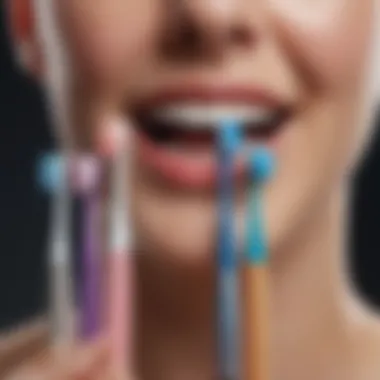

The Bass Technique
The Bass technique is often recommended by dental professionals for its effectiveness in plaque removal. This method primarily targets the area where the gum meets the tooth. To execute this technique:
- Position the toothbrush at a 45-degree angle to the gum line.
- Use gentle, short strokes to clean the surface of each tooth.
- Make sure to massage the gum line gently, which can help in removing plaque without causing damage to the gums.
This method is particularly useful for individuals with periodontal issues, as it allows for thorough cleaning without aggression. A significant benefit of the Bass technique is that it promotes gum health by facilitating increased blood flow through gentle stimulation.
The Circular Technique
The Circular technique involves brushing in small, circular motions. This approach is straightforward and effective for many users. Steps involve:
- Placing the bristles against the teeth at a 45-degree angle.
- Moving the toothbrush in circular motions to cover all surfaces of the teeth.
Users often find this technique easier to perform than others. The circular motion helps to dislodge food particles and plaque effectively. However, it's essential to ensure that the pressure is light to prevent gum irritation. This technique works well for children or anyone new to effective toothbrushing habits.
The Fones Technique
The Fones technique is characterized by wide circular motions that encompass both the teeth and gums. It is especially popular for younger children. To use this approach:
- Position the toothbrush bristles against the teeth.
- Move the brush in large circles, covering multiple teeth at once.
- Ensure gentleness to avoid damaging the gums.
While this method is engaging for young users and may increase compliance, it may not offer the same depth of cleaning as more meticulous techniques. Therefore, it is often beneficial to combine the Fones technique with other methods for optimal results.
The Stillman Technique
The Stillman technique incorporates elements of both the Bass and Circular techniques, making it a hybrid approach. To implement this method:
- Hold the toothbrush bristles at a 45-degree angle to the gum line.
- Use a combination of light pressure and circular motions to sweep over both teeth and gums.
This technique is advantageous for promoting healthy gums as it encourages gentle brushing along the gum line while also cleaning the sides of the teeth effectively. Users should maintain a delicate touch to prevent recession or irritation of the gums, yet still achieve adequate plaque removal.
As brushing techniques play a central role in maintaining dental hygiene, understanding and practicing these methods can significantly influence overall oral health. Individuals may find it helpful to experiment with these techniques to determine which one best addresses their unique needs and preferences.
Proper Brushing Duration and Frequency
Proper toothbrushing duration and frequency are central to maintaining oral health. Research indicates that many people overlook this aspect, leading to less effective plaque removal and increased risk for dental issues. Understanding the science behind how long and how often we should brush can significantly impact the overall effectiveness of one's oral hygiene regimen.
Recommended Brushing Duration
The American Dental Association recommends brushing for at least two minutes twice a day. This time frame allows sufficient opportunity for effective cleaning of the tooth surfaces. It is also important to distribute the brushing within the mouth evenly. Failing to brush for the recommended duration can result in plaque accumulation, which can lead to cavities and gum disease.
The duration can be divided among different areas of the mouth: front, back, and chewing surfaces of teeth. Practicing a timed approach may help in achieving the suggested brushing duration. One common method is to divide the mouth into four quadrants and spend thirty seconds per quadrant, ensuring that all areas receive attention.
Some individuals may find it helpful to use a timer or an electric toothbrush with a built-in timer. The important goal is to ensure comprehensive coverage without rushing through the process.
Brushing Frequency: Myths and Facts
There are several myths surrounding toothbrushing frequency. One common misconception is that brushing after every meal is necessary. While it is commendable to brush often, brushing three times a day can lead to gum irritation or enamel wear if too much pressure is applied during brushing. The optimal frequency is twice daily.
Consider these facts about brushing frequency:
- Twice a Day: Brushing in the morning helps to remove plaque accumulated overnight, while brushing before bedtime helps eliminate food particles and plaque that form throughout the day.
- Brushing After Snacks: If eating sugary or acidic snacks, rinsing with water is recommended, but brushing should still be reserved for the primary twice-daily sessions.
- Before Bed: This is critical as saliva production decreases during sleep. Ensuring teeth are clean before sleep can help reduce bacteria growth.
"Regular brushing, with a focus on duration and frequency, mitigates dental diseases and fosters long-term oral health."
Maintaining a balance with brushing frequency is vital, as an excessive focus on cleanliness can lead to unhealthy practices. Therefore, adhering to the guideline of brushing twice a day for two minutes will effectively enhance oral health without adverse effects.
Common Mistakes in Toothbrushing
Toothbrushing is a fundamental part of daily oral hygiene. However, many individuals do not execute this practice correctly, leading to common mistakes that can detrimentally affect dental health. Understanding these errors is crucial for improving techniques and ensuring effective cleaning. This section will delve into these common mistakes to highlight their impact on oral care and to guide towards better habits.
Inadequate Technique
One of the primary mistakes in toothbrushing is inadequate technique. Many people brush their teeth in a hurried or ineffective manner, often neglecting proper angles and movements. A common issue is using a back-and-forth scrubbing motion that can cause gum recession and enamel wear. Instead, dental experts recommend adopting a more systematic approach, such as using the Bass technique, which suggests angling the toothbrush at 45 degrees to the gum line.
Another aspect of inadequate technique includes the duration of brushing. Many individuals fail to brush for the recommended two minutes, which reduces the effectiveness of plaque removal. It is important to use a timer or a toothbrush that provides feedback to ensure adequate coverage of all tooth surfaces during the brushing session.
Using Excessive Force
Using excessive force while brushing is another prevalent mistake. Many believe that brushing harder will yield better results; however, this is contrary to effective dental care. Brushing too vigorously can harm the enamel on teeth and irritate the gums, leading to increased sensitivity and periodontal issues.
The proper approach involves applying gentle pressure. The bristles of the toothbrush should sweep the surfaces rather than scrub vigorously. Electric toothbrushes often have pressure sensors that can help in maintaining the correct force while brushing, thus aiding in preventing future dental problems.
"Brushing too aggressively can do more harm than good, increasing the risk of gum disease and tooth decay."
Neglecting Certain Areas
A significant error in many brushing routines is neglecting certain areas of the mouth. Commonly ignored spots include the back molars and the gum lines where plaque tends to accumulate. Failing to clean these areas regularly can lead to cavities and gum disease, undermining overall oral health.
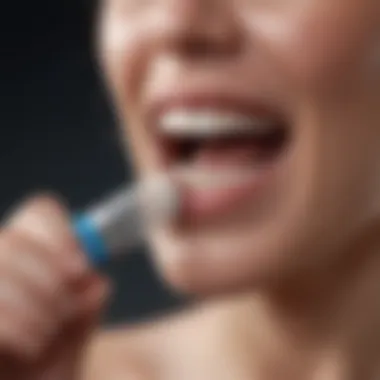
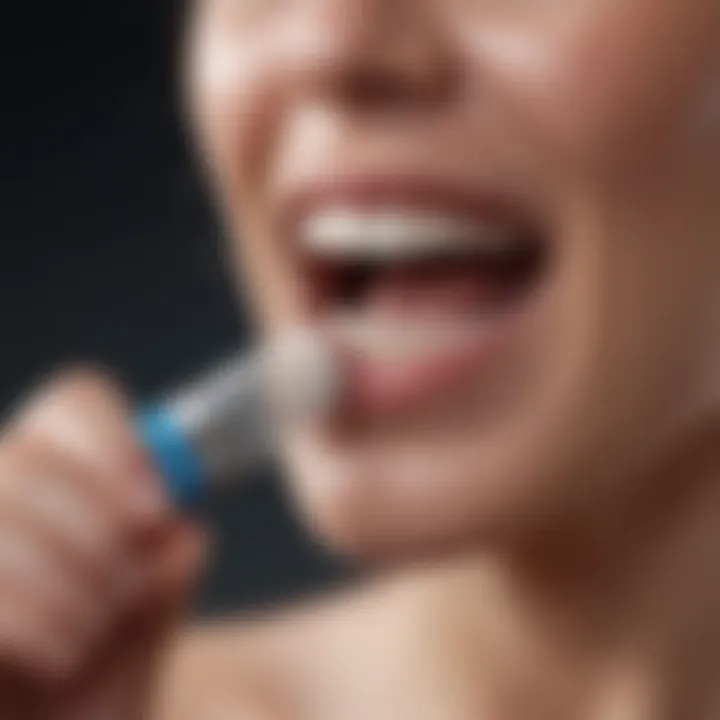
To overcome this mistake, individuals should consciously ensure they are reaching all parts of their mouths while brushing. It can help to divide the mouth into quadrants and spend designated time on each section. Additionally, maintaining a checklist of areas to address can reinforce thorough cleaning. A structured brushing routine helps to ensure that no area is overlooked.
Incorporating these elements into your tooth brushing routine can significantly improve oral hygiene. Being aware of these common mistakes not only enhances one’s dental care but also emphasizes the importance of technique in maintaining overall health.
The Role of Toothpaste
Toothpaste plays a crucial role in maintaining oral hygiene, serving as an essential component of any toothbrushing routine. Selecting the right toothpaste can significantly enhance the effectiveness of brushing, improving overall dental health. A variety of factors contribute to the importance of toothpaste, including its formulation, ingredients, and the specific needs of the user. It acts not only as a medium to facilitate the physical cleaning of teeth but also provides various benefits that target oral health concerns.
Factors worth considering when evaluating toothpaste include its efficacy in combating cavities, its ability to remove plaque, and the presence of specific ingredients tailored for sensitive teeth or whitening effects. Good oral care is multifaceted. Thus, understanding the role of toothpaste is paramount for optimizing brushing habits.
Types of Toothpaste
When it comes to types of toothpaste, the options available can be overwhelming. However, these various types cater to specific needs. Some common types include:
- Fluoride Toothpaste: This type contains fluoride, a mineral that strengthens tooth enamel and helps prevent decay.
- Whitening Toothpaste: Formulated with abrasives and chemical agents to help remove surface stains and whiten teeth over time.
- Sensitivity Toothpaste: Designed for individuals with sensitive teeth, these pastes often contain potassium nitrate or strontium chloride to alleviate discomfort.
- Herbal and Natural Toothpaste: Made with natural ingredients, these do not contain fluoride and appeal to those seeking more organic options.
- Children's Toothpaste: Specifically made for children, these pastes are often lower in fluoride and come in fun flavors to encourage brushing.
Choosing the right type depends on individual dental needs and preferences.
Fluoride and Its Benefits
Fluoride is a key ingredient in many toothpaste formulations. It is crucial to emphasize the benefits of fluoride for anyone interested in maintaining optimal dental health. Here are some significant advantages:
- Strengthens Enamel: Fluoride helps to remineralize tooth enamel, making it more resistant to acid attacks that cause cavities.
- Reduces Cavities: Regular use of fluoride toothpaste can significantly reduce the risk of developing cavities, a common issue faced by people of all ages.
- Inhibits Bacterial Growth: Fluoride can disrupt the metabolism of harmful bacteria in the mouth, thereby reducing plaque formation and preventing gum disease.
"Fluoride is effective in decreasing the incidence of dental caries in children and adults alike."
Post-Brushing Care
Post-brushing care is an often overlooked yet critical component of an effective oral hygiene routine. Proper care immediately following toothbrushing can help maximize the effects of brushing and ensure your mouth remains clean and healthy. This section will highlight various aspects of post-brushing care, including rinsing techniques and guidelines for replacing your toothbrush.
Rinsing Techniques
Rinsing after brushing helps remove loosened plaque and food particles. However, it is important to do it correctly to avoid washing away fluoride, which is vital for strengthening tooth enamel.
Here are some effective rinsing techniques:
- Water Rinse: After brushing, rinse your mouth thoroughly with water. This helps to clear any remaining toothpaste or debris.
- Fluoride Mouthwash: Using a fluoridated mouthwash post-brushing can enhance your oral care regimen. Swishing with mouthwash allows the fluoride to coat your teeth, offering added protection against decay.
- Avoiding Immediate Eating or Drinking: Ideally, avoid food and drinks for at least 30 minutes after brushing. This allows time for the fluoride to take effect and provides a barrier against acids.
"The act of brushing alone does not determine oral health; it is the care following brushing that solidifies those efforts."
When to Replace Your Toothbrush
Most dental professionals recommend replacing your toothbrush every 3 to 4 months. However, certain signs may prompt an earlier replacement. Here are the key considerations:
- Worn Bristles: If the bristles appear frayed or bent, it is time to replace the toothbrush. Worn bristles cannot clean teeth effectively and may harm gums.
- Illness: Should you experience an illness such as a cold or flu, consider replacing your toothbrush afterward. Bacteria and viruses can linger on the brush, risking reinfection.
- Type of Toothbrush: Electric toothbrush heads also require replacement every 3 to 6 months, based on usage. Following manufacturer recommendations is essential for maintaining optimal hygiene.
Establishing a routine for post-brushing care is just as essential as the brushing itself. It contributes significantly to maintaining oral health and can prevent various dental issues.
Brushing for Special Populations
Brushing techniques and habits vary greatly across different age groups and circumstances. This segment of the article focuses on the significance of adapting oral hygiene practices for special populations. Understanding the unique needs of children, seniors, and individuals with disabilities is essential for effective oral care. These groups face specific challenges and considerations that influence their toothbrushing routines. As such, tailored approaches not only ensure optimal oral hygiene but also promote a lifelong commitment to health.
Brushing for Children
Children have unique oral health needs that require attention from an early age. Teaching proper toothbrushing techniques can set the tone for a lifetime of healthy habits. It is important to introduce brushing around the age of two, once the first teeth emerge. This ensures they become accustomed to daily oral care as a normal part of their routine.
When brushing children's teeth, parents should use a soft-bristled toothbrush suitable for young mouths. A small amount of fluoride toothpaste, no larger than a pea, is recommended. Children often do not develop the dexterity to brush effectively until about age 6 or older. Therefore, adult supervision and assistance are crucial during this time.
Some helpful tips for parents include:
- Make toothbrushing a fun and engaging activity.
- Use positive reinforcement to encourage good habits.
- Explain the benefits of brushing in simple terms to children.
Brushing for Seniors
As individuals age, oral health can decline due to various factors such as medication side effects, reduced dexterity, and chronic conditions. For seniors, maintaining proper toothbrushing techniques is vital to prevent common issues such as gum disease and tooth decay. It is essential for them to use a toothbrush with an easy-grip handle if their hands are weak or arthritic.
Seniors should also pay special attention to the following:
- Opt for fluoride toothpaste to strengthen teeth and prevent cavities.
- Use an electric toothbrush if manual brushing is challenging.
- Maintain regular dental visits to assess oral health.
Education about the importance of oral hygiene will benefit seniors, as awareness can lead to a more proactive approach toward their dental care.
Brushing with Disabilities
Individuals with disabilities may encounter various challenges in maintaining proper oral hygiene. Factors such as limited mobility, cognitive impairments, or sensory issues can complicate traditional toothbrushing techniques. Therefore, customized approaches that cater to these unique needs are essential.
Some strategies include:
- Adaptive Equipment: Use specially designed toothbrushes that are easier to hold and maneuver.
- Routine Establishment: Create a structured routine that includes toothbrushing at the same time each day.
- Assistance: Family members or caregivers should assist where necessary, ensuring that all areas of the mouth are effectively cleaned.
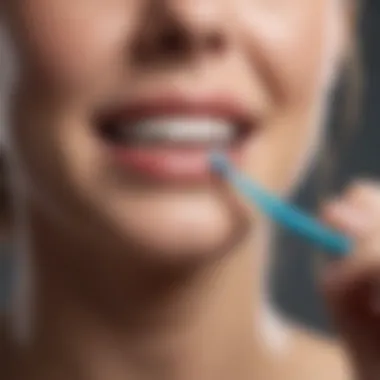
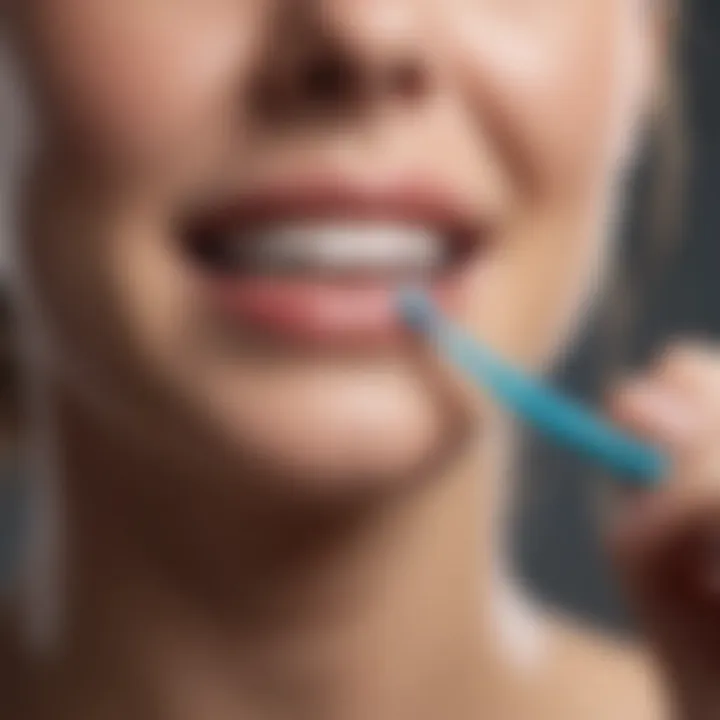
Education for caregivers and family members about the specific needs of individuals with disabilities plays a crucial role in their oral health. Utilizing accessible resources and providing support can significantly improve the brushing experience for these populations.
Providing tailored oral hygiene practices for special populations enhances their overall health outcomes. It is crucial to address their specific needs and support them in developing meaningful hygiene habits.
Technological Advances in Toothbrushing
Technological advances in dental care are transforming the way people approach oral hygiene. This section examines the influence of modern innovations in toothbrush design and functionality, as well as the integration of digital tools for improved dental habits. Understanding these developments is essential for optimizing brushing practices and promoting better oral health outcomes.
Smart Toothbrushes
Smart toothbrushes represent a leap forward in oral hygiene technology. These devices are equipped with sensors that provide real-time feedback on brushing habits. Users can connect smart toothbrushes to their smartphones via Bluetooth. The data collected includes pressure, duration, and coverage, helping to identify areas that may require more attention.
Benefits of Smart Toothbrushes:
- Enhanced Feedback: Users get immediate alerts if they are brushing too hard or skipping important areas.
- Personalized Recommendations: Some models offer tailored brushing techniques based on user data.
- Gamification: Many smart toothbrushes include features that make brushing fun, promoting consistent use, especially for children.
When integrating a smart toothbrush into an oral care routine, it's crucial for users to consistently review the app’s suggestions to harness its full potential. Regular data insights can help in forming better brushing habits over time.
Mobile Applications for Oral Hygiene
Mobile applications play an increasingly vital role in promoting effective oral hygiene practices. Many of these apps, which pair with smart toothbrushes, guide users through their brushing routine. They often include timers, instructional videos, and progress tracking, making them a valuable resource for individuals of all ages.
Advantages of Mobile Applications:
- Visualization: Users can see their progress and identify trends over time.
- Reminders: Apps can send push notifications to remind users when it’s time to brush, floss, or schedule dental check-ups.
- Educational Resources: Many apps offer articles, videos, and quizzes to educate users about oral health.
Implementing these applications can significantly enhance user engagement with dental care routines. Increased awareness and education about oral hygiene contribute to long-term health benefits.
"Incorporating technology into dental care encourages a proactive approach to maintaining oral health."
By understanding and utilizing technological advancements, individuals can more effectively engage with their oral hygiene practices, leading to improved outcomes in dental health.
Oral Health Beyond Brushing
To achieve optimal oral health, it is essential to understand that toothbrushing, while crucial, is only one component of comprehensive dental care. Skipping basic elements such as flossing and regular dental check-ups could undermine efforts to maintain a healthy mouth. This section will delve into key practices that complement brushing, ensuring that complete oral hygiene can be achieved.
Flossing: An Essential Component
Flossing is vital for cleaning between the teeth, where toothbrushes cannot reach. Toothbrush bristles generally miss these tight spaces, creating an opportunity for plaque buildup and cavities. Flossing should be performed at least once a day. This practice helps remove food particles and plaque that accumulate in between the teeth and along the gum line.
- Benefits of Flossing:
- Reduces Gum Disease: Flossing removes harmful bacteria and reduces the risk of gingivitis.
- Prevents Bad Breath: Food trapped between teeth can lead to unpleasant odors.
- Contributes to Overall Health: Poor oral hygiene is linked to conditions such as heart disease and diabetes.
It is important to use the correct technique when flossing. Slide the floss between your teeth gently, making a C-shape around each tooth. This method removes debris without damaging the gums. Choose a floss type that suits your needs, such as waxed or unwaxed, and consider devices like floss picks or water flossers for added ease.
“Ignoring flossing is a common mistake that can cost you your dental health in the long run.”
Regular Dental Check-ups
Regular dental check-ups play a pivotal role in maintaining oral health. These visits allow for professional cleaning and examination of the teeth and gums, uncovering potential issues. This includes evaluating for cavities, gum disease, and other oral health problems that may be developing unseen.
- Importance of Check-ups:
- Early Detection: Dentists can spot issues early, providing solutions before they develop into larger problems.
- Professional Cleaning: Even with diligent brushing and flossing, it is impossible to remove all tartar. Regular check-ups ensure thorough cleaning by professionals.
- Guidance and Education: Dental professionals can provide personalized advice on the best oral hygiene practices for individual needs.
In general, it is advisable to visit a dentist every six months. However, individuals with specific conditions, or a history of dental problems, may need more frequent visits. Adhering to regular dental check-ups significantly supports overall oral health, making it an essential act alongside brushing and flossing.
Closure and Best Practices
In understanding the significance of toothbrushing techniques, it is essential to synthesize the information discussed throughout this guide. Oral hygiene is a critical aspect of overall health, and adopting effective brushing methods is fundamental for maintaining healthy teeth and gums. This article has explored various brushing techniques as well as the tools and practices that support optimal oral health. The final section aims to consolidate this knowledge into actionable practices that can be easily incorporated into daily routines.
Effective toothbrushing goes beyond simply using a toothbrush. It involves understanding the mechanics of brushing and integrating good habits. From this, we can identify several key elements that contribute to a successful brushing regimen:
- Technique: Utilizing appropriate methods such as the Bass or Circular techniques ensures thorough cleaning of tooth surfaces and gum lines.
- Duration and Frequency: Adhering to the recommended two minutes of brushing, twice a day, maximizes efficiency and effectiveness in removing plaque and preventing decay.
- Proper Tools: Choosing the right toothbrush and toothpaste suited to individual needs can significantly enhance brushing results.
By focusing on these essentials, one can establish a routine that promotes better dental health.
Good habits in oral care develop a foundation for a lifetime of healthy smiles.
Summary of Effective Techniques
This article has introduced various toothbrushing techniques, each aiming to ensure optimal removal of plaque and food residues. Summarizing these methods can support readers in selecting the best practices for their needs. Here are the most effective brushing techniques:
- Bass Technique: This method is effective for gum health, using soft strokes at a 45-degree angle to reach beneath the gum line.
- Circular Technique: Gentle circular motions can be efficient for those who prefer a less forceful approach, ensuring coverage of the entire tooth surface.
- Fones Technique: Best for children, it employs large circular sweeping motions to engage and encourage consistent brushing habits.
- Stillman Technique: Ideal for sensitive gums, this method uses vibratory strokes to avoid trauma while still effectively cleaning the teeth.
Incorporating these effective techniques into daily habits can immensely contribute to oral health.
Incorporating Good Habits
Establishing consistent practices around toothbrushing is critical for long-lasting oral hygiene. To achieve this, consider the following suggestions:
- Establish a Routine: Choose specific times in the morning and evening to brush your teeth. Consistency helps in forming a habit.
- Set Reminders: Use a toothbrush with a built-in timer or mobile applications to track brushing time and guide you on technique.
- Motivation through Education: Understand the repercussions of neglecting dental care, such as cavities and gum diseases, to reinforce the importance of brushing.
- Regularly Evaluate Your Tools: Change your toothbrush every three to four months and ensure it suits your personal needs.
By integrating these habits into daily life, individuals can improve their oral health significantly. Empower yourself with knowledge and practice, leading to lasting benefits.
By summarizing effective techniques and encouraging good habits, this article aims to foster a comprehensive understanding of toothbrushing practices and the role they play in maintaining oral hygiene.



